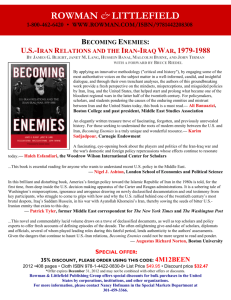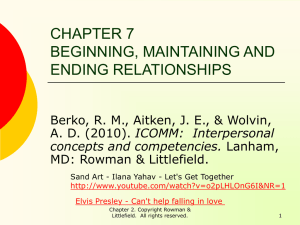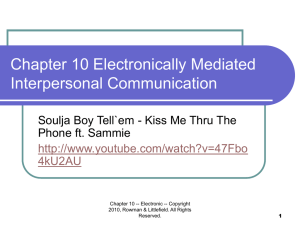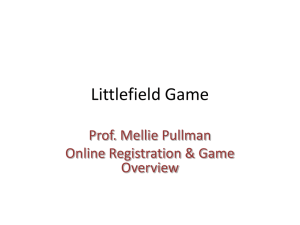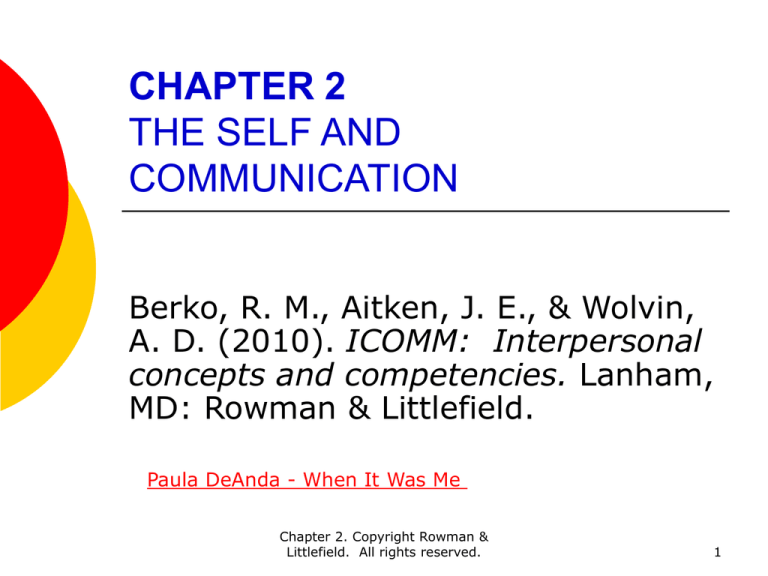
CHAPTER 2
THE SELF AND
COMMUNICATION
Berko, R. M., Aitken, J. E., & Wolvin,
A. D. (2010). ICOMM: Interpersonal
concepts and competencies. Lanham,
MD: Rowman & Littlefield.
Paula DeAnda - When It Was Me
Chapter 2. Copyright Rowman &
Littlefield. All rights reserved.
1
Intrapersonal Communication
Self-communication.
Systematic interfacing with the self.
Social reality--a relationship outside
of a social context and making it
real through processing ideas
internally.
Chapter 2. Copyright Rowman &
Littlefield. All rights reserved.
2
Self-talk
Influences
Behavior.
Your feelings.
Your self-esteem.
Your level of stress.
Inner attitudes, our attitudes shape
our behavior.
Chapter 2. Copyright Rowman &
Littlefield. All rights reserved.
3
Avoid the Psychological Vulture
Attacks a person’s perceived
weaknesses.
Eats at the person’s self-worth.
Chapter 2. Copyright Rowman &
Littlefield. All rights reserved.
4
Typical Self-Putdowns (Vultures)
Intelligence vultures.
Creativity vultures.
Family vultures.
Relationship vultures.
Physical vultures.
Sexual vultures.
Chapter 2. Copyright Rowman &
Littlefield. All rights reserved.
5
Self-fulfilling Prophecy
What you predict to happen, will
happen.
What you expect to do wrong, will
be done wrong.
Chapter 2. Copyright Rowman &
Littlefield. All rights reserved.
6
Private List
Take a minute to jot down all the
vultures that eat at you.
Think about behaviors you could try
to change them.
Talk with a partner about ideas for
changing the things that bother you
and interfere with effective
interpersonal communication.
Chapter 2. Copyright Rowman &
Littlefield. All rights reserved.
7
Effective self-talk can include
various memory techniques:
Chunking.
Ordering.
Reordering.
Context organizing.
Mnemonics.
Chapter 2. Copyright Rowman &
Littlefield. All rights reserved.
8
Talk about It
Discuss memory strategies you use
to prepare for tests.
Chapter 2. Copyright Rowman &
Littlefield. All rights reserved.
9
COGNITIVE PROCESSING
Each of us carries with us values
(what you perceive to be of positive
or negative worth), attitudes (your
perspective and viewpoints), and
beliefs (your convictions).
Chapter 2. Copyright Rowman &
Littlefield. All rights reserved.
10
IMBALANCE
The imbalance between your values,
attitudes, and beliefs is called
cognitive dissonance.
Guilty conscience.
Instead of brooding: There is
nothing you can do about it now,
and go on from there, with the
internal pledge of not doing it again.
Chapter 2. Copyright Rowman &
Littlefield. All rights reserved.
11
SELF-CONCEPT
Self-confidence—a feeling of
competence and self-assurance.
Self-esteem--an awareness that
we are distinct.
Choice Therapy--we live and act in
the moment as people responsible
for ourselves.
Chapter 2. Copyright Rowman &
Littlefield. All rights reserved.
12
THE SELF
Idealized self--what you perceive
yourself to be if you were "perfect.“
Real self--what you think of
yourself when you are being most
honest about your interests,
thoughts, emotions, and needs.
Chapter 2. Copyright Rowman &
Littlefield. All rights reserved.
13
Should self--contains all the
"oughts" and "shoulds" that serve
as your moral guidelines.
Public self--the you you let others
know.
Chapter 2. Copyright Rowman &
Littlefield. All rights reserved.
14
THEORIES OF SELF-CONCEPT
Self: the spiritual, the material, the
social, and the physical.
Social interaction.
Situational.
Chapter 2. Copyright Rowman &
Littlefield. All rights reserved.
15
UNDERSTANDING YOUR SELF
Johari window
Photo from
http://farm4.static.flickr.com/3094/3151607460_0f90928833.jpg
Chapter 2. Copyright Rowman &
Littlefield. All rights reserved.
16
Johari Window Self Analysis
How well do you know yourself?
How open are you with others?
Chapter 2. Copyright Rowman &
Littlefield. All rights reserved.
17
SELF-IDENTITY AND
COMMUNICATION
Social Interaction Theory claims
that the presentation of our self is
actually a carefully conceived
performance.
Chapter 2. Copyright Rowman &
Littlefield. All rights reserved.
18
COMMUNICATION ANXIETY
Publicly anxious people are
strongly hesitant about
communicating with others.
Privately anxious people mentally
resist active communication, but will
participate--often by forcing
themselves.
Chapter 2. Copyright Rowman &
Littlefield. All rights reserved.
19
Other concerns to consider:
Listener apprehension.
Effects of communication anxiety.
Chapter 2. Copyright Rowman &
Littlefield. All rights reserved.
20
Solutions
Skill training to deal with anxiety.
Systematic desensitization.
Cognitive modification.
Willingness to communicate.
Drug therapy.
Chapter 2. Copyright Rowman &
Littlefield. All rights reserved.
21
Positive Visualization
Practice positive visualization.
Accept the anxiety.
Chapter 2. Copyright Rowman &
Littlefield. All rights reserved.
22
Try Positive Visualization about an
Upcoming Conversation
Chapter 2. Copyright Rowman &
Littlefield. All rights reserved.
23
Application Learning Activities
Discuss with a partner or small group
members or complete on your own
outside class.
Chapter 2. Copyright Rowman &
Littlefield. All rights reserved.
24
PSYCHOLOGICAL VULTURES
Consider these suggestions for eliminating
psychological vultures. Give an example of each
by writing our self talk you can use right now.
Pat yourself on the back by saying something
good about yourself.
Pat someone else on the back by saying
something good and true about her or him.
Recognize your self-put-downs.
Block each put-down.
Turn the put-down around.
Positive self-talk plus visualization
Chapter 2. Copyright Rowman &
Littlefield. All rights reserved.
25
AFFIRMATIONS
Make a list of ten positive affirmations,
which are meaningful to you. You may
look on the Internet for inspiration at
Banish negative self talk or Positive
Affirmations to Reverse Negative Self
Talk or a site of your choice. You may
want to convert them into refrigerator
magnets, for example (see
http://www.MotivationalRefrigeratorMagn
ets.com) Read the list every day for a
month or specified time length of your
choosing. Does reading the list have an
effect?
Chapter 2. Copyright Rowman &
Littlefield. All rights reserved.
26
Complete the Willingness to
Communicate (WTC)
Discuss or write a reflection about
your score and what it means. You
may want to write a plan for
improving your communication
skills. http://www.jamescmccroske
y.com/measures/WTC.htm
Chapter 2. Copyright Rowman &
Littlefield. All rights reserved.
27
DOVE
Find some of the Dove advertisements
about self esteem and beauty. What is
the effect of the media on selfesteem? Are there different pressures for
women than men? See for example, The
Dove self-esteem Fund or a Dove film Girl's self-esteem or find your own
Internet example. Discuss or write a brief
reflection by relating what you find to a
concept in the chapter.
Chapter 2. Copyright Rowman &
Littlefield. All rights reserved.
28
END
CHAPTER 2
THE SELF AND
COMMUNICATION
Berko, R. M., Aitken, J. E., & Wolvin, A. D. (2010).
ICOMM: Interpersonal concepts and competencies.
Lanham, MD: Rowman & Littlefield.
Visuals from Microsoft Clipart or as marked.
Chapter 2. Copyright Rowman &
Littlefield. All rights reserved.
29

